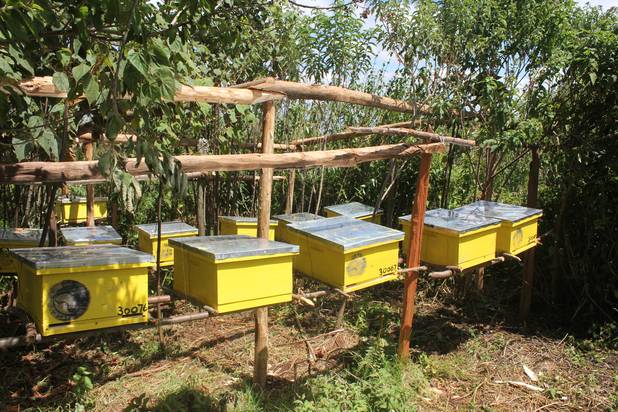Smallholder farmers can double their honey yields from 10kgs to 20kgs by adopting the use of modern beehives such as the Langstroth hive system which ensure easy harvesting.
According to the African bee keepers, the producers of the contemporary beehive, a farmer can collect 20 to 30kgs of honey per harvest from Langstroth as opposed to the traditional log hives which fetch between 10 to 15kg.
Related content
The story of bees and the liquid gold of an Ogiek farmer
Know and protect bees to improve crop yields
The Langstroth beehive uses a multi-layered structure and removable frames to encourage bees to build their hives in an orderly fashion and make it easy for bee keepers to harvest honey. The frames are designed to separate honeycombs as bees attach honeycombs to adjacent frames making it easier for bee keepers to manage the bees and honey collection effortlessly.
“Our Langstroth beehives are wholly Kenyan made using local material and are all fitted with 100 per cent bees wax comb starters, comb strips that are locally produced from bees wax coming from our local bees thus assuring quick colonization and free from foreign diseases transmitted from imported bees wax” said Ernest Simeoni, African Bee Keepers, operations manager.
“I would recommend Langstroth bee hives to farmers who like to venture into bee keeping as a business as it improves production of honey”
Langstroth bee hive
Kenya produces approximately 7300 tonnes of honey every year, 700 less than what Tanzania produces according to the United States Agency for International Development (USAID).
In this, farmers can take advantage of the opportunity to undertake bee keeping as a commercial activity to earn extra income. A kilo of honey in Kenya fetches between Sh400 to Sh1000 depending on the location. This means farmers can earn Sh30000 per harvest with one Langstroth beehive as compared to Sh10,000 with the traditional beehive.
Farmers can purchase the Langstroth beehive from African bee keepers at the cost of Sh5000 per hive. The hive is normally fitted with beeswax to attract bees.
Bees require little capital and land to keep. In setting up an apiary farmers should consider availability of water within a three kilometer radius. Flowers should also be present as they contain nectar, a sweet liquid secreted by flowers which is an important ingredient in the honey making process. The apiary should be free from disturbances, noise and free from human beings and animals. It ought to be in a sheltered place protected from strong sun and wind.
When stocking, different ways can be used to encourage the bees to enter into an empty bee hive. One is use of swarm nets which are fixed high up on the trees trap bees. A catcher box with bees wax can also be used to attract bees. Once the bees have occupied it, they can be transferred to the main bee hive. This is done by placing the main hive on a higher position with the catcher box connected with a sloping board a as the bees usually move upward. A few puffs of smoke is then used to drive the bees into the hive.
In a colony, worker bees are about 60,000 in number, drones are approximately 300 and there is only one queen whose function is to lay fertile eggs and keeping the colony together. Approximately five to seven drones are required to mate the queen who then lays between 1500- 2000 eggs per day. Mating only takes place once as the queen stores the sperms in a spermatheca for future use.
Various pests that attack bees include the wax moth, bee louse, and honey badgers. To control the pests, all infected combs should be removed and burnt except for honey badger whereby the hive is suspended by use of wires to prevent them from climbing the hive and eating honey.
Farmers should take note when bees swarm, this can be due to shortage of food, overcrowding, dampness and bad smell, damage of brood combs or an infertile queen. To rectify this, regular checking should be done.
Honey takes an average of one year to mature. When harvesting it, protective gear should be worn. The process should be done in the morning or late in the evening when bees are less active. A bucket or pail can be used to collect the honey comb with the aid of a bee brush to brush off bees back into the hive.

















Comments powered by CComment